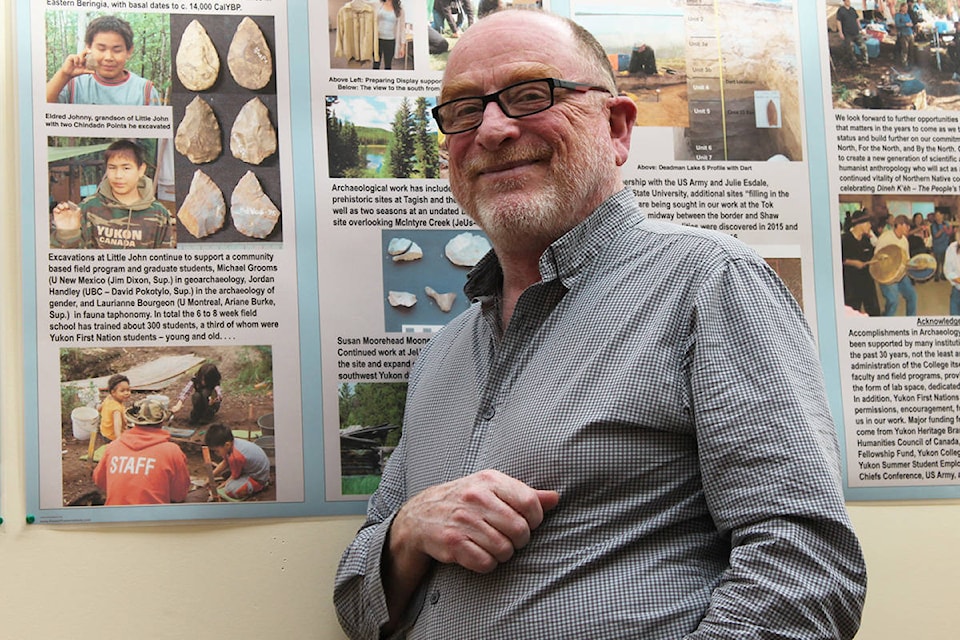For more than three decades, a major focus of Norman Easton’s career has been the Yukon/Alaska borderlands and those who call the region home.
The work of the Yukon University anthropology instructor has culminated in the recently published An Ethnohistory of the Chisana River Basin by the U.S. National Park Service.
The publication, documenting First Nations of the upper Tanana River, is a new edition of the originally published work Easton did in 2005. The original work was an internal document for the park service aimed at ensuring staff had a good background in the history of the region.
In a May 3 interview, Easton added that although the document was intended for park staff, there’d normally be two or three inquiries each year from other people looking for a copy to learn about family history or the area. In addition to that, Easton found himself providing copies to colleagues who asked about it.
Easton said the revised and updated publication has been produced with a more general audience in mind.
In the fall of 2019, the park service contacted Easton and asked if he’d be willing to revise and update the document. Over the course of a little more than a year, he reviewed his original work and then revised and added to the information, including more details about the region and its people.
“They put a lot of resources in bringing it up for a professional grade publication,” Easton said.
In late April, the 149-page document became available online with plans for hard copies to be published in the coming months.
“We are grateful to Norm Easton and YukonU for their partnership in making this important cooperative project possible and pleased to be able to share the results with both the local communities and the visiting public,” said Barbara Cellarius, cultural anthropologist, Wrangell-St. Elias National Park and Preserve.
While the revision work took just over a year, the publication draws on Easton’s decades visiting the region, getting to know the people and the culture and conducting archeological digs with students.
In the 1990s, Easton began keeping records of the region’s history.
“I began working with people up in the region, documenting oral history, traditions, land use,” he said.
That work included recording stories passed down by elders and extensively researching documents about the region found in both Canadian and American archives.
Easton highlighted his interest in the home of the Dineh people — an area that sits in the Wrangell-St. Elias National Park and Preserve, and the Tetlin National Wildlife Refuge.
The remote location meant local First Nations retained their autonomy and traditional ways longer than most other nations in North America, until the building of the Alaska Highway.
A series of reports on a variety of topics followed over the years with Easton expanding on the work with archeological digs involving students from what was then Yukon College (now Yukon University).
Then in 2005, Easton was asked by the park service to put together the first ethnohistory document he produced about the area. That project saw Easton travel to archives in both Canada and the United States, taking in written histories of the land.
As he recalled though, most of those written accounts don’t highlight the encounters First Nations had with settlers who came through the area, surveying the boundaries. They also don’t mention the treaty signed that allowed the Dineh to move between the border that was drawn up between The Yukon and Alaska.
His time working with the Dineh and recording their oral history made it clear to Easton that government agents signed off on an agreement in a book that granted the First Nations permission to move across the border. Easton noted that once the border line had been drawn and the government agents moved on, there was very little contact between the Dineh and settlers until the building of the Alaska Highway. In the meantime, the First Nations continued to cross the arbitrary line that had been drawn through their traditional territory.
Easton said the oral history tells a different story than the documents, citing the border agreement being omitted from the documents kept by government agents, but being remembered by the Dineh.
“It’s fascinating,” he said of the area’s history.
The ethnohistory publication is available online through the park service.
With Easton set to retire soon from his role at Yukon University, he’s hoping to spend more time focusing on the borderlands. Easton is looking at writing a more detailed history of the region in four volumes over the next few years. They would explore in detail the prehistory, the social history to 1950, the social history after 1950, and the cultural geography as well as place names and cultural land use.
Contact Stephanie Waddell at stephanie.waddell@yukon-news.com
